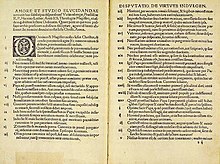Ninety-five Theses: Difference between revisions
Brian Sisco (talk | contribs) Reverted edit by 61.68.2.239 to last version by KFP |
|||
| Line 1: | Line 1: | ||
[[Image:95Thesen.jpg|thumb|The 95 Theses.]] |
[[Image:95Thesen.jpg|thumb|The 95 Theses.]] |
||
The '''''Disputation of [[Martin Luther]] on the Power and Efficacy of Indulgences''''', known as the '''95 Theses''', challenged the teachings of the [[Roman Catholic Church]] on the nature of [[penance]], the authority of the [[pope]] and the usefulness of [[indulgence]]s. They sparked a [[theology|theological]] debate that would result in the [[Protestant Reformation|Reformation]] and the birth of the [[Lutheran]], [[Reformed]], and [[Anabaptist]] traditions within [[Christianity]]. |
The '''''Disputation of [[Martin Luther]] on the Power and Efficacy of Indulgences''''', known as the '''95 Theses''', challenged the teachings of the [[Roman Catholic Church]] on the nature of [[penance]], the authority of the [[pope]] and the usefulness of [[indulgence]]s. They sparked a [[theology|theological]] debate that would result in the [[Protestant Reformation|Reformation]] and the birth of the [[Lutheran]], [[Reformed]], and [[Anabaptist]] traditions within [[Christianity]]. |
||
(perhaps someone could post a list of the theses here, with a list of the 41 which Luther withdrew, and his reasons for doing so?) |
|||
==Purpose of the Theses== |
==Purpose of the Theses== |
||
{{lutheranism}} |
{{lutheranism}} |
||
Revision as of 02:56, 3 January 2007

The Disputation of Martin Luther on the Power and Efficacy of Indulgences, known as the 95 Theses, challenged the teachings of the Roman Catholic Church on the nature of penance, the authority of the pope and the usefulness of indulgences. They sparked a theological debate that would result in the Reformation and the birth of the Lutheran, Reformed, and Anabaptist traditions within Christianity.
Purpose of the Theses
| Part of a series on |
| Lutheranism |
|---|
 |
The Castle Church located in Wittenberg was the site of one of Europe's largest single collections of relics, accumulated by Elector Frederick the Wise. Relics are objects considered to be holy and the viewing of which is considered to be meritorious, allowing the viewer to receive relief from temporal punishment for sins in purgatory. By 1509, the Elector "already owned 5,005 of them, including several vials of the milk of the Virgin Mary, straw from the manger [of Jesus], and the entire corpse of one of the innocents massacred by King Herod. These relics were kept in reliquaries — artistically wrought vessels mostly of silver gilt — and exhibited once a year for the faithful to venerate. In 1509, each devout visitor who donated toward the preservation of the Castle Church received an indulgence of one hundred days per relic."[1] By 1520, the Elector's collection of relics had increased to 19,013 allowing pilgrims to the Castle Church to receive an indulgence that would reduce their time in purgatory by 5,209 years.[2]
Luther's actions, however, were in great part a response to the selling of indulgences by Johann Tetzel, a Dominican priest, commissioned by the Archbishop of Mainz and Pope Leo X. The purpose of this fund raising campaign was to finance the renovation of St. Peter's Basilica in Rome. Even though Luther's prince, Frederick the Wise, and the prince of the neighboring territory, George, Duke of Saxony, forbade the sale in their lands, Luther's parishioners traveled to purchase them. When these people came to confession, they presented the plenary indulgence, claiming they no longer had to repent of their sins, since the document promised to forgive all their sins.
Nailed or mailed?

Luther is said to have posted the 95 Theses on the door of the Castle Church in Wittenberg, Germany, October 31, 1517. Some scholars have questioned the accuracy of this account, noting that no contemporaneous evidence exists for it.[3] Others have countered that no such evidence is necessary, because this action was the customary way of advertising an event on a university campus of Luther's day.[4] Church doors at the time functioned very much as modern bulletin boards. Still others suggest the posting may well have happened sometime in November 1517. Most agree that, at the very least, Luther mailed the theses to the Archbishop of Mainz, the pope, friends and other universities on that date.[5] Regardless, the Theses were soon printed and had been widely read in Europe by 1518. (Fire destroyed the doors of the Castle Church in 1760.)
Reaction to the 95 Theses
Pope Leo X wished for Martin Luther to recant 41 of these theses, which Luther famously refused to do before the Diet of Worms in 1521, thus symbolically initiating the Protestant reformation.[6]
Notes
- ^ Martin Treu, Martin Luther in Wittenberg: A Biographical Tour (Wittenberg: Saxon-Anhalt Luther Memorial Foundation, 2003), 15.
- ^ Treu, 15.
- ^ Erwin Iserloh. The Theses Were Not Posted: Luther Between Reform and Reformation. trans. by Jared Wicks, S.J.. Boston: Beacon Press, 1968.
- ^ Helmar Junghans, "Luther's Wittenberg," in The Cambridge Companion to Martin Luther, ed. Donald K. McKim (New York: Cambridge University Press, 2003), 26
- ^ Junghans, 26.
- ^ Schaff, Philip, History of the Christian Church, Vol VII, Ch III
Bibliography
- Erwin Iserloh. The Theses Were Not Posted: Luther Between Reform and Reformation. trans. by Jared Wicks, S.J.. Boston: Beacon Press, 1968.
